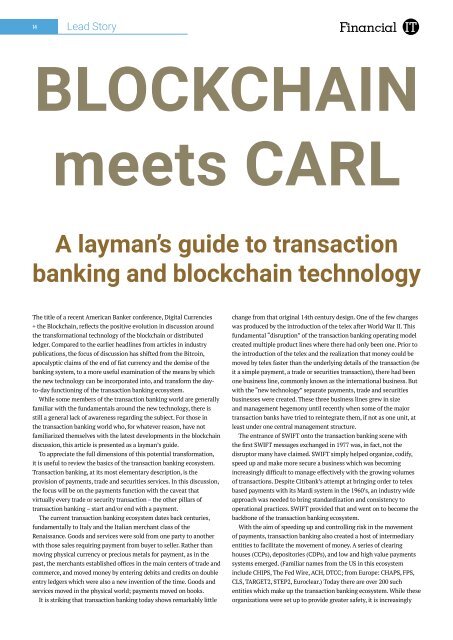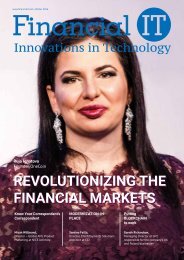Revolutionizing the Financial Markets
You also want an ePaper? Increase the reach of your titles
YUMPU automatically turns print PDFs into web optimized ePapers that Google loves.
14<br />
Lead Story<br />
BLOCKCHAIN<br />
meets CARL<br />
A layman’s guide to transaction<br />
banking and blockchain technology<br />
The title of a recent American Banker conference, Digital Currencies<br />
+ <strong>the</strong> Blockchain, reflects <strong>the</strong> positive evolution in discussion around<br />
<strong>the</strong> transformational technology of <strong>the</strong> blockchain or distributed<br />
ledger. Compared to <strong>the</strong> earlier headlines from articles in industry<br />
publications, <strong>the</strong> focus of discussion has shifted from <strong>the</strong> Bitcoin,<br />
apocalyptic claims of <strong>the</strong> end of fiat currency and <strong>the</strong> demise of <strong>the</strong><br />
banking system, to a more useful examination of <strong>the</strong> means by which<br />
<strong>the</strong> new technology can be incorporated into, and transform <strong>the</strong> dayto-day<br />
functioning of <strong>the</strong> transaction banking ecosystem.<br />
While some members of <strong>the</strong> transaction banking world are generally<br />
familiar with <strong>the</strong> fundamentals around <strong>the</strong> new technology, <strong>the</strong>re is<br />
still a general lack of awareness regarding <strong>the</strong> subject. For those in<br />
<strong>the</strong> transaction banking world who, for whatever reason, have not<br />
familiarized <strong>the</strong>mselves with <strong>the</strong> latest developments in <strong>the</strong> blockchain<br />
discussion, this article is presented as a layman’s guide.<br />
To appreciate <strong>the</strong> full dimensions of this potential transformation,<br />
it is useful to review <strong>the</strong> basics of <strong>the</strong> transaction banking ecosystem.<br />
Transaction banking, at its most elementary description, is <strong>the</strong><br />
provision of payments, trade and securities services. In this discussion,<br />
<strong>the</strong> focus will be on <strong>the</strong> payments function with <strong>the</strong> caveat that<br />
virtually every trade or security transaction – <strong>the</strong> o<strong>the</strong>r pillars of<br />
transaction banking – start and/or end with a payment.<br />
The current transaction banking ecosystem dates back centuries,<br />
fundamentally to Italy and <strong>the</strong> Italian merchant class of <strong>the</strong><br />
Renaissance. Goods and services were sold from one party to ano<strong>the</strong>r<br />
with those sales requiring payment from buyer to seller. Ra<strong>the</strong>r than<br />
moving physical currency or precious metals for payment, as in <strong>the</strong><br />
past, <strong>the</strong> merchants established offices in <strong>the</strong> main centers of trade and<br />
commerce, and moved money by entering debits and credits on double<br />
entry ledgers which were also a new invention of <strong>the</strong> time. Goods and<br />
services moved in <strong>the</strong> physical world; payments moved on books.<br />
It is striking that transaction banking today shows remarkably little<br />
change from that original 14th century design. One of <strong>the</strong> few changes<br />
was produced by <strong>the</strong> introduction of <strong>the</strong> telex after World War II. This<br />
fundamental “disruption” of <strong>the</strong> transaction banking operating model<br />
created multiple product lines where <strong>the</strong>re had only been one. Prior to<br />
<strong>the</strong> introduction of <strong>the</strong> telex and <strong>the</strong> realization that money could be<br />
moved by telex faster than <strong>the</strong> underlying details of <strong>the</strong> transaction (be<br />
it a simple payment, a trade or securities transaction), <strong>the</strong>re had been<br />
one business line, commonly known as <strong>the</strong> international business. But<br />
with <strong>the</strong> “new technology” separate payments, trade and securities<br />
businesses were created. These three business lines grew in size<br />
and management hegemony until recently when some of <strong>the</strong> major<br />
transaction banks have tried to reintegrate <strong>the</strong>m, if not as one unit, at<br />
least under one central management structure.<br />
The entrance of SWIFT onto <strong>the</strong> transaction banking scene with<br />
<strong>the</strong> first SWIFT messages exchanged in 1977 was, in fact, not <strong>the</strong><br />
disruptor many have claimed. SWIFT simply helped organize, codify,<br />
speed up and make more secure a business which was becoming<br />
increasingly difficult to manage effectively with <strong>the</strong> growing volumes<br />
of transactions. Despite Citibank’s attempt at bringing order to telex<br />
based payments with its Mardi system in <strong>the</strong> 1960’s, an industry wide<br />
approach was needed to bring standardization and consistency to<br />
operational practices. SWIFT provided that and went on to become <strong>the</strong><br />
backbone of <strong>the</strong> transaction banking ecosystem.<br />
With <strong>the</strong> aim of speeding up and controlling risk in <strong>the</strong> movement<br />
of payments, transaction banking also created a host of intermediary<br />
entities to facilitate <strong>the</strong> movement of money. A series of clearing<br />
houses (CCPs), depositories (CDPs), and low and high value payments<br />
systems emerged. (Familiar names from <strong>the</strong> US in this ecosystem<br />
include CHIPS, The Fed Wire, ACH, DTCC; from Europe: CHAPS, FPS,<br />
CLS, TARGET2, STEP2, Euroclear.) Today <strong>the</strong>re are over 200 such<br />
entities which make up <strong>the</strong> transaction banking ecosystem. While <strong>the</strong>se<br />
organizations were set up to provide greater safety, it is increasingly







